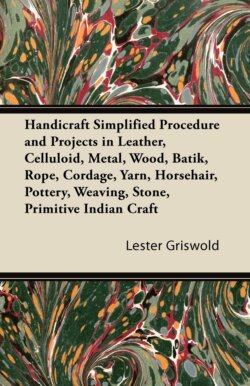Читать книгу Handicraft Simplified Procedure and Projects in Leather, Celluloid, Metal, Wood, Batik, Rope, Cordage, Yarn, Horsehair, Pottery, Weaving, Stone, Primitive Indian Craft - Lester Griswold - Страница 42
На сайте Литреса книга снята с продажи.
Punching
ОглавлениеPunching.
Sketch J above shows punch and the hole spacing gauge, with gauge tip inserted in the first hole punched in the corner of the leather touching the creaser lines. Sketch K shows a method of securing two pieces of leather to hold them in place while being punched. Thread or string is tied through the corner holes. The punching operation is indicated and should be continued to within about 1/2 to 3/4 of an inch from the corner. At this point, Cut B, observe the intervening space to make sure how many holes will be required. It may be necessary to slightly increase or decrease the spacing in order to make the corner hole come right. A good practice is to estimate the spacing and mark lightly the position of the holes, before punching either with, or independently of the gauge. If the anvil becomes rough from use, the under margin of the holes may be marred. To prevent this, smooth the anvil occasionally with a fine file. In any case it is desirable to punch with the outside of an article uppermost. A piece of thin leather or paper held underneath the purse while punching will prevent scratching and save the edge of the tube.
AB
Cementing a Lining.
Fig. 3, page 64, shows the manner of applying the cement to the skived edge of an unlined article. In Sketch C the lining is shown as attached to a folded article, such as the flap of a bag. The flat surfaces are first cemented smoothly together along the fold, then placed over a block or table edge with the lining against the edge, at the point where the fold is to be made. Apply cement along the fold and out to edges of flap. Then press carefully together, working toward the outer margin of the flap, smoothing out any wrinkles in the lining. Sketch B shows the method of smoothing out any wrinkles in the lining by rubbing toward the edge with a bone folder. Additional cement may be necessary if it becomes too dry to adhere. The same thing may be accomplished as indicated in Sketch E. Here the lining is kept smooth and all bulging and wrinkles worked out between the thumb and fingers as the fold is gradually made. This method is satisfactory for small articles.
Note—Bookbinder’s flexible glue or rubber cement should be used. Do not use a glue which becomes hard and makes the leather stiff when dry.
Fig. 6
